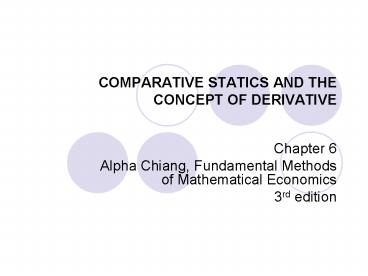COMPARATIVE STATICS AND THE CONCEPT OF DERIVATIVE PowerPoint PPT Presentation
1 / 20
Title: COMPARATIVE STATICS AND THE CONCEPT OF DERIVATIVE
1
COMPARATIVE STATICS AND THE CONCEPT OF DERIVATIVE
- Chapter 6
- Alpha Chiang, Fundamental Methods of Mathematical
Economics - 3rd edition
2
Nature of Comparative Statics
- concerned with the comparison of different
equilibrium states that are associated with
different sets of values of parameters and
exogenous variables. - we always start by assuming a given initial
equilibrium state. Then ask how would the new
equilibrium compare with old. - can either be qualitative (direction) or
quantitative (magnitude) - problem under consideration is essentially one of
finding rate of change - concept of derivative takes significance
differential calculus
3
Rate of Change and the Derivative
Difference quotient
Derivative y f(x) 3x2-4
Notation f(x), f
4
Skipped Topics
- The Derivative and Slope of the Curve
- The Concept of Limit
- Digression on Inequalities and Absolute Values
- Limit Theorems
- Continuity and Differentiability of a function
5
RULES OF DIFFERENTIATION AND THEIR USE IN
COMPARATIVE STATICS
- Chapter 7
- Alpha Chiang, Fundamental Methods of Mathematical
Economics - 3rd edition
6
Rules of Differentiation for a Function of One
Variable
Constant Function Rule
Power Function Rule
Generalized Power Function Rule
7
RULES OF DIFFERENTIATION INVOLVING TWO OR MORE
FUNCTIONS OF THE SAME VARIABLE
Sum-Difference Rule
Product Rule
Quotient Rule
8
Relationship between Marginal Cost and Average
Cost Functions
Book example
9
RULES OF DIFFERENTIATION INVOLVING FUNCTIONS OF
DIFFERENT VARIABLES
Chain Rule If we have a function zf(y) where y
is in turn a function of another variable x, say
yg(x) then the derivative of z with respect to x
is equal to the derivative of z with respect to
y, time the derivative of y with respect to x
10
Examples of Chain Rule
11
Examples of Chain Rule
12
Examples of Chain Rule
Example 4 Given a total revenue function of a
firm Rf(Q) where output Q is a function of
labor input L, or Q g(L), derive the marginal
revenue product of labor
13
Inverse Function Rule
If a function y f(x) represents a one-to-one
mapping, i.e. if the function is such that a
different value of x will always yield a
different value of y, the function f will have an
inverse function x f-1(y). This means that a
given value of x yields a unique value of y, but
also a given value of y yields a unique value of
x. The function is said to be monotonically
increasing if
Practical way of ascertaining monotonicity if
the derivative f(x) always adheres to the same
algebraic sign. Examples
14
PARTIAL DIFFERENTIATION
15
PARTIAL DIFFERENTIATION
Techniques of Partial Differentiation Just hold
(n-1) independent variables constant while
allowing one variable to vary.
Example 1
Example 2
16
Applications To Comparative-static Analysis
Market Model
17
Applications To Comparative-static Analysis
Market Model
Four partial derivatives
Conclusion
18
Applications To Comparative-static Analysis
National Income Model
19
Applications To Comparative-static Analysis
National Income Model
20
(No Transcript)

